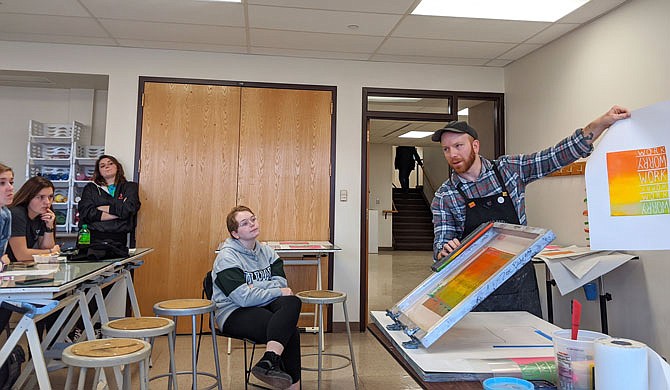When it comes to accessible, affordable and experimentation-friendly art mediums, it's hard to beat screen printing, according to Tennessee artist Nick Satinover.
"It's very good at making simple things look complex," he said.
A display of Satinover's art, titled "Intervals, Assemblages, Accumulations," is on display until Dec. 10 at William Woods University's Mildred Cox Gallery. On Thursday, he stopped by WWU for the exhibit's opening reception and give a demonstration of his silk screening techniques.
Satinover has exhibited in juried, group and solo exhibitions nationally and internationally. He currently serves as an associate professor of print media at Middle Tennessee State University. His work features bright colors paired with words and phrases, often highlighting contrasting ideas. For his demonstration, he brought a screen featuring the words "work" and "worry" repeated several times along one side of the page.
"It's important to me to make images that look fun, but when you look at that the text is more contemplative," he said, slapping bright green and pink ink at the edge of the screen. "The colors seduce the viewer into looking closer."
Silk screening is a simple and ancient technique for quickly and accurately producing many copies of a design. Satinover explained how his version of the technique works. It involves coating the screen in a liquid that hardens to plastic when in contact with light. After allowing the screen to dry in darkness, he places a design - drawn onto something semi-transparent, such as tracing paper - on top and exposes it to light.
The areas not covered by the design harden, and everything else is easily rinsed away. From there, the screen is placed into the frame, which holds it firmly in place. A piece of paper goes under the screen, and Satinover uses a squeegee to pull ink in an even layer across the top.
After that dries, he can layer more transparent ink across the top, change the print's orientation and so on.
"You can make the same screen print a million different ways," Satinover said. "Because I'm indecisive, I want to see a couple different options before I commit."
The rigid structure provided by the screen also works well with the way he creates art, he said.
"As someone who builds art from the concept out, efficiency is important," Satinover said. "I can't add any information to the image, but I can throw on different ink. It also means I don't have to think about color until the very end."
Screen printing has a low barrier to entry compared to other forms of art, he said. Acrylic inks are non-toxic and wash away easily, and a basic screen printing set can cost as little as $60.
"It's an affordable way to increase and distribute your ideas and images," he said.
In his own classes, it's typically the first form of printing he teaches. He gave audience members a chance to test it out with his work/worry screen.
"I'm pretty confident," WWU student Dane Chandler said as he prepared to pull the squeegee across the screen. "The problem is, you make it look easy."
Moments later, he had his own print to take home.
Satinover said his students usually grasped the basics of the technique by the day's end, though they may become rather paint-spattered in the process.
"It takes a day to learn but a lifetime to master," he said.

